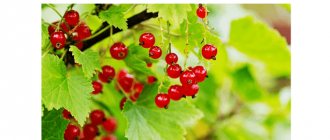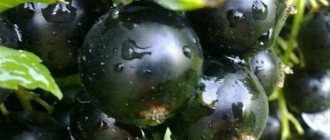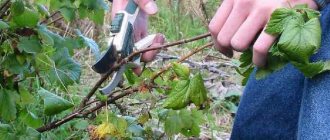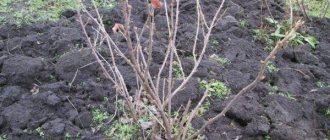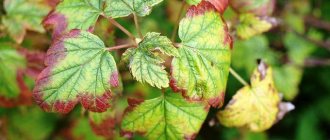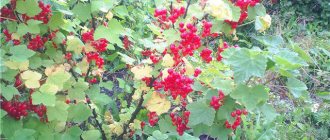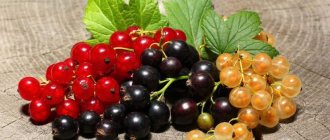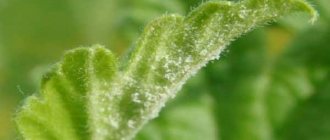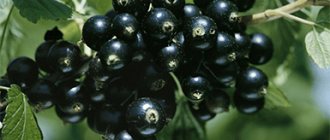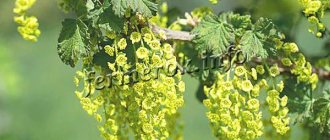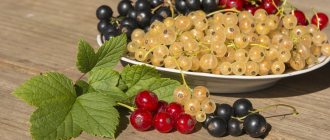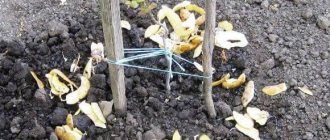Red currant Beloved has been popular among summer residents for decades. She fully lives up to the name given to her. Compact bushes with shiny red clusters are a decoration and delight for any summer resident. This variety is not pretentious, but it is famous for its abundant harvests.
This variety of currant was developed by Belarusian scientific breeders in the late eighties. The author Volzunev was amazed by the beauty of the variety - clusters of ruby berries shimmered among the lush green mass. It was he who gave the new hybrid the name Beloved.
Currants owe their taste, as well as other qualities, to three varieties - Dutch red, Cherry and Wonderful. It was from them that she inherited the best characteristics. Since 2006, this variety has been officially cultivated in Russia.
Description of the variety
The beloved red currant was bred by Belarusian breeders in the late 80s of the last century. It was included in the State Register of plant varieties permitted for cultivation in Russia only in 2006.
The bushes of this currant variety are neat and low. Young shoots are olive in color with a lilac tint. Lignified twigs are grayish-brown. The shoots of the Beloved variety are smooth and thickened, with medium-sized buds evenly distributed along them.
The leaves are matte, large in size, their edges are wavy. Each leaf has five projections, of which the middle one is the largest.
The flowers are relatively large, shaped like bowls. The sepals are pale green in color, with a reddish tint. Currants begin to bloom in early May and flowering continues for two weeks.
The fruit clusters are arched, dense, and grow downward. The berries are round, regular in shape, rich in color, with few seeds in the middle. The average weight of berries reaches 0.7 grams. The berries have a refreshing sweet and sour taste. The tasters' rating is high - 4.8 points out of 5 possible.
The beloved currant is considered a mid-season variety. Ripens in late June – early July. Young bushes produce up to 3 kg of berries, while adults can harvest 10 kg of berries.
Characteristics of the bush
During the assessment, the following quality indicators are monitored:
- The shoots are quite large and straight, the buds are oval in shape. The color varies from purple-red in young shoots to gray in older, woody shoots.
- The leaves are quite large and have a five-pointed shape, somewhat reminiscent of a maple leaf, the surface of the leaf is rough, without shine, the teeth on the edges are blunt.
- The flowers are greenish-yellow in color and shaped like saucers. They appear in the first days of May and bloom by the middle of the month.
- The berries are red with dark stripes, with a small number of seeds inside. The fruits, collected in clusters, are approximately the same in size, each weighing about a gram (0.8 g). The berries are juicy, soft and very sweet with a slight sourness. They are able not to crumble for a long time and do not lose their taste and appearance.
According to tasting assessments, the variety is classified as sweet and is assigned 4.8 out of 5 for taste quality. Beloved berries are ideal for jam and go well in taste with summer apple varieties: Orlinka, Medunitsa, Druzhba Narodov.
Advantages of the variety
Reviews about the Beloved red currant variety are the most positive. Gardeners note a number of advantages of this variety.
- The Beloved currant variety tolerates temperature changes and frosts well. There is no need to insulate the bushes for the winter, which greatly simplifies care.
- High yield. With proper care, you can collect more than 10 kg of berries from one mature bush.
- The variety is self-fertile. To obtain a high yield, pollination by bees or cross-pollination with other varieties is not required.
- The variety is resistant to pests and most diseases, including powdery mildew.
- The fruits have good taste. The berries contain a lot of sugar, vitamin C, pectin, as well as mineral and organic compounds.
- Ripe berries do not fall off the bushes and do not lose their quality for a long time.
- The tear off is dry, which makes transportation and storage easier.
The Beloved red currant variety is considered universal. The fruits can be consumed fresh, juices, compotes and canned food can be prepared from them for the winter.
This variety has only one drawback - Beloved currant is not resistant to leaf spot.
Bushes of this variety are small, which allows them to be planted compactly in a personal plot.
Beloved - red currant
The variety was developed in the late 1980s in Belarus by the famous breeder A.G. Voluznev. This name was given to the plant for a reason, because it turned out to be really beautiful and bright. Related varieties, with the help of which the Beloved currant was bred, “gave” their best qualities:
- Cherry - high yield,
- Wonderful - big sweet berries,
- Dutch red - frost resistance and disease resistance.
Ripening time
The Beloved currant belongs to the average ripening period; ripeness occurs in mid-summer (late June - early July).
Productivity
The productivity of the variety is high. Young bushes are modest, allowing you to collect about 3 kg of berries. But mature bushes can give a generous harvest of about 12 kg. Self-fertility is 60%, which is an undoubted advantage of the variety. That is, in order to get a consistently high yield, you do not need special conditions in the form of cross-pollination, insect flight or suitable weather. The maximum harvest can be harvested after 3-5 years of plant life.
Berry size
Currant berries are soft, juicy, red with dark stripes, and equal in size. The weight of the berry is a little less than a gram; there are seeds inside, but there are few of them. Even after reaching maturity, the berries do not fall off and do not lose their taste. It is convenient to transport - the currants do not choke and retain a presentable appearance. The sugar content in berries ranges from 6 to 12%; a high level of organic acids, tannins, and pectins is also noted. There is a lot of vitamin C - 30.2 mg/100 g.
Taste qualities
Tasting score - 4.8 out of 5. The berry has a pleasant sweet and sour taste. Currants are consumed both fresh and canned - in the form of preserves, jams, confitures. They also make healthy juice from red “beloved” currants, which has a beneficial effect on the functioning of the gastrointestinal tract and helps remove uric acid salts. During a cold, this juice is simply irreplaceable. The high content of preservatives allows currants to be used for pickling tomatoes and cucumbers.
Disease resistance
The beloved currant is highly resistant to a whole list of diseases and insects. Powdery mildew, anthracnose, and bud mite are not harmful to the plant. Fungal diseases will also not cause any particular inconvenience. However, this variety also has weaknesses:
- septoria (white spot) - appears in early June in the form of small round spots on the leaves, which then turn white. Over time, the leaves dry out and fall off. Before flowering and after harvesting, spray with Bordeaux mixture, and in the fall, diseased foliage is burned;
- Goblet rust is a fungal disease that can lead to the loss of half the crop. They fight like this - spray with Bordeaux mixture three times (when the foliage blooms, when the buds appear and after flowering).
Bush size
Bushes of the Beloved variety are low, round in shape, compact . During harvest, the branches are densely dotted with bright red clusters of berries. The shoots are large, the buds are oval. Those that are younger are reddish with a purple tint, and those that are older are gray. The shape of the leaf may resemble maple, the leaf itself has no shine, and there are blunt teeth along the edge. The brushes are about 7 cm long, each with 12-14 berries.
Geography of the variety
The Beloved variety is universal, winter-hardy and frost-resistant , therefore suitable for cultivation in almost any region. In central Russia it is possible to cultivate without shelter in winter.
Video review
Care Tips
Bushes should be planted in slightly acidic loamy soil, enriched with nutrients and well-drained. If there is a close occurrence of groundwater (50 cm), then currants should be planted on a hill. The plant is planted in early autumn; a couple of hours before planting, the seedling is soaked in water so that it then quickly forms young roots. If the roots are dry or broken, they need to be removed.
You can and should plant bushes in open places - the plant loves light. You can plant gooseberries nearby, but you shouldn’t plant blackcurrants. The bush is planted in a hole 60 cm deep and 50*50 cm in size. The life of the bush can reach 20-25 years. Fertilizers are added to the planting hole - wood chips or broken branches are sprinkled at the very bottom, sprinkled with earth, and chalk, ash or dolomite are added on top. The plant does not like fertilizers with chlorine.
Having placed the seedling in the hole, sprinkle it with earth, but do not compact it - the earth should stick to the roots. The distance between bushes should be at least 1.5 m.
When planting, cut the seedlings short, leaving 3-4 buds. After pruning, the soil is raked to a height of 10-12 cm, and in the spring it is unearthed. In the second year of the bush’s life, in the spring, pruning is repeated according to the same pattern, and so on every year.
Fertilize the plant with urea, humus, spray with a solution of boric acid, mulch with compost, peat, fertilizers with phosphorus and potassium. Water a lot, but rarely - 3-4 times per season, 3-5 buckets per bush.
With many advantages, only one drawback can be noted - susceptibility to leaf spots.
Choosing a landing site
Beloved currant grows well in non-acidic and loamy soils. Before planting, it is necessary to add organic and mineral fertilizers to the soil. Bushes do not like excessive moisture, so when planting in low-lying areas, it is necessary to arrange drainage.
To plant red currant bushes, choose a sunny, open place; you can plant seedlings next to gooseberry bushes; such proximity will not hurt.
It is not recommended to plant red and black currants side by side on the site, as the bushes will not get along.
You can plant shrubs near fences, on hills. It’s good if the bushes are blocked on the north side by a fence from the wind. The distance between red currant bushes should be at least one and a half meters.
Reproduction methods
Red currants are not difficult to propagate yourself. To do this, use cuttings, layering or dividing the bush.
Cuttings
At the beginning of summer, currants can be propagated by green cuttings. To do this, you will need a semi-lignified shoot of the current season. The cut cuttings should have 2-3 internodes. The lower leaves and tops should be removed, and the remaining foliage should be cut in half to reduce moisture evaporation.
The cuttings are planted in perlite or sand, which should be moist. It must be placed obliquely, at 45°, deepening it by about 2 cm. The plant planted in this way is covered with a glass jar or film. After rooting, the currants are transplanted into open ground.
In the fall, you can prepare lignified cuttings from one-year-old root shoots or 2-3-year-old branches. The length of such a cutting is 18–20 cm, and the diameter is about 8 mm. After cutting, the planting material should be placed in damp sand and left indoors for the winter at a temperature of +2...+3°C. In the spring, the cuttings are planted in the tree at an angle, leaving 2 buds on the surface. The planting is covered with film, the soil moisture is maintained and rooting is waited until September, after which it is transplanted to the place chosen for the bush.
Video: Propagation of currants by cuttings
By layering
This method is most suitable for black currants, but it can also be used for red varieties, taking into account that the rooting process will take longer. With the onset of spring, the mature shoot should be bent to the soil and fixed in one or several places on previously loosened soil. Receiving sufficient watering and nutrition from the mother bush, the shoot will give its roots. By the time autumn arrives, the rooted cuttings are separated and replanted.
If the currants need to be moved to a new location, the bush can be divided by performing sanitary pruning first. The dug plant is cut into pieces, leaving developed roots on each of them. The cut site is disinfected, for example, with crushed charcoal. The pits for the divisions should be 5–7 cm deeper than the maternal one. In the new location, the plants are shortened to 20 cm and moistened daily until rooting.
Landing Features
The most successful time for planting Beloved red currants is considered to be the beginning of autumn. The plant is planted according to the following algorithm:
- dig a hole with a diameter of half a meter and a depth of at least 60 cm;
- chips or crushed twigs are poured into the bottom of the hole and sprinkled with a layer of soil on top;
- a couple of glasses of crushed chalk are mixed with a tablespoon of potassium fertilizer and also poured into the hole;
- pour a layer of compost on top and sprinkle with a layer of earth;
- 2 buckets of water are poured into the hole, after it is absorbed the layers settle;
- pour a heap of earth into the hole, lower the seedling and spread the roots over the mound;
- the first three buds from the root should be covered with soil;
- it is allowed to mix the soil with sand if it is too heavy;
- After filling the hole, the plant is watered abundantly.
If after watering bare roots are visible, they are sprinkled with a layer of dry earth, but not compacted. The seedling is pruned before or immediately after planting, leaving 4 buds on the surface.
Before planting, it is recommended to soak the seedlings for 3 hours in water with the addition of the drug “Kornevin”.
Agricultural technology
To obtain maximum benefit and yield from the crop, it is important to follow the rules of planting and further care of the plant.
Choosing a place and landing
Slightly acidic loamy soils are considered the most suitable place for planting red currants of the Beloved variety. The soil should be light, slightly moist, well-drained, and also rich in minerals. Groundwater should lie deep, otherwise it is better to plant the plant on hills. In low areas, the crop produces a modest harvest and the berries become smaller.
If planting needs to be done in heavy clay areas with high acidity, the soil should be stabilized in advance with peat or sand.
The place should be open to sunlight and well lit
Light is an important component of plant yield quality
Any crops can be suitable as neighbors. However, it is best to plant the plant near gooseberry varieties that have a beneficial effect on the growth of the bush and fruit. However, it is not recommended to place the Beloved variety near black currant varieties. The optimal time for planting the plant is considered to be early autumn.
Important! Currants are considered long-lived, so they require an ideal place for planting. The life span of the shrub is more than 25 years. When purchasing a seedling, it is necessary to check the condition of the root system, which should be especially developed
The plant should have at least 1-2 main roots, as well as a large number of adventitious ones. The roots should be sufficiently moist, without damage or breaks. To ensure the health of the shoots, you can make a small cut. The inside color should be green.
When purchasing a seedling, it is necessary to check the condition of the root system, which should be especially developed. The plant should have at least 1-2 main roots, as well as a large number of adventitious ones. The roots should be sufficiently moist, without damage or breaks. To ensure the health of the shoots, you can make a small cut. The inside color should be green.
Currant planting scheme:
- First you need to prepare the soil, dig it up and apply fertilizers in the form of organic matter and minerals.
- Dig a hole at least 60 cm deep. The ideal hole size is 50x50 cm. The holes should be located at a distance of more than 2 m. In the future, the bushes will need enough space for further development.
- 2 hours before planting, it is necessary to prepare a red currant seedling for planting. To do this, you need to tear off the dry roots, shorten the stems, leaving about 6 buds, and place the plant in water.
- Next, the plant should grow new roots. For a faster effect, it is recommended to add Kornevin solution to the water.
- Wood chips or finely chopped branches should be poured into a thick layer at the bottom of the prepared hole.
- Next, you need to spread the fertilizer with fertile soil, pour dolomite, chalk, compost or river sand on top.
- To compact all layers, you need to fill the hole with water.
- After this, a mound of earth is formed at the bottom of the hole.
- Before planting the plant, be sure to straighten the roots.
- Bury the seedling into the ground by 3 buds.
- Plant the plant with the stem slightly tilted to the side.
- Cover the seedling with soil. If the soil is too hard, it is recommended to add a little sand.
- Water the bush generously. If the roots are on the surface, sprinkle them with soil.
- There is no need to compact the soil.
Trimming
The bush is pruned in the second year of life. Weak and crooked shoots are removed to the very root, leaving only 4 strong branches. Bushes are pruned in the same way in subsequent years. Every year there should be 3-4 strong branches left. In the fifth year of life, the currant has more than 10 main branches.
According to reviews, the beloved red currant produces the most abundant harvest from the third year of life. After the final formation of the bush, you should not trim the branches, even if they seem too long.
Watering
Red currants of the Beloved variety do not require compliance with a special watering schedule. Water the bushes as needed 1-2 times a month. At least three buckets of water are poured onto the bush at a time. A ditch is first dug around the bush and a bucket of water is poured into it. After it is absorbed, add the rest of the water.
You can water currant bushes only in the evening. You should not water during the day, as the scorching rays of the sun will steam the roots.
In October, it is recommended to water the bushes abundantly. This is necessary so that the plants have time to accumulate useful substances before wintering.
Fertilizer
Red currant bushes Beloved are not particularly demanding on soil fertility. If mineral and organic fertilizers were applied to the hole during planting, then the currants should be fertilized again only in the second year. At this time, it is recommended to add urea or humus to the soil.
At the end of spring, the bushes are fertilized with mullein, diluting it at the rate of 100 grams per liter of water. To increase productivity, during flowering the bushes are sprayed with a solution of boric acid. It is prepared at the rate of 2 grams of dry matter per 10 liters of water. Spraying is carried out in the evening in dry weather.
You can scatter a layer of mulch 10 cm thick around the bush. This can be humus or peat. Once a season, while digging the ground, potassium or phosphorus-containing fertilizers are poured.
Diseases and pests
The description of Beloved red currant states that the variety is resistant to many pests and diseases, including those of a fungal nature. But gardeners should be aware that there are also enemies.
- Glass rust.
Appears on bushes if damp weather lasts for a long time. The solution to the problem comes down to spraying the bushes three times with Bordeaux mixture. - Septoria.
Before flowering and immediately after harvesting, the bushes are sprayed with Bordeaux mixture or Fitosporin.
If there are diseased currant bushes on the site, the leaves are collected and burned in the fall to prevent the spread of infection. In addition, the bushes around are being dug up.
The Beloved red currant variety compares favorably with long-known varieties. This crop is resistant to frost and drought and produces a large harvest of tasty and strong berries.
History of selection and region of breeding
The Beloved variety was bred in the late 1980s in Belarus at the Institute of Fruit Growing of the Republican Academy of Sciences.
The author of the variety, a famous breeder, Doctor of Biological Sciences Anatoly Grigorievich Voluznev, called his brainchild “Beloved” for a reason - it turned out to be an amazingly beautiful plant, you can’t take your eyes off the rich dark greenery, abundantly sprinkled with rubies of berries.
The parents of this currant were three varieties - Cherry, Wonderful and Dutch Red. They all gave their “daughter” the best qualities.
Cherry - high yield and marketable appearance of fruits, Wonderful - large and sweet berries, and Dutch red - winter hardiness and resistance to many diseases.
In 1991, Beloved was included in the State Register of Varieties of Belarus, and in 2006 it was officially allowed to be cultivated in Russia.
In these regions, red currant varieties such as Marmeladnitsa, Natali, Andreichenko are also successfully grown. As well as black currant varieties: Gulliver, Gross, Belorusskaya sweet, Bagira and Dachnitsa.
